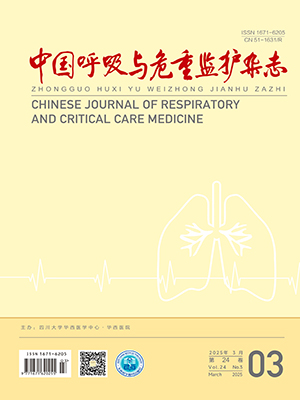| 1. |
陈红梅, 张建华, 徐仑.KL-6与呼吸系统疾病.国际儿科学杂志, 2008, 35:137-139.
|
| 2. |
Kondo T, Hattori N, Ishikawa N, et al. KL-6 concentration in pulmonary epithelial lining fluid is a useful prognostic indicator in patients with acute respiratory distress syndrome. Respir Res, 2011, 12:32-38.
|
| 3. |
杜玉秀, 多力坤·木扎帕尔, 马香萍.病毒性肺炎患儿血清糖蛋白KL-6水平与影响因素相关性.中华实用诊断与治疗杂志, 2011, 25:460-462.
|
| 4. |
Kawase S, Hattori N, Ishikawa N, et al. Change in serum KL-6 level from baseline is useful for predicting life-threatening EGFR-TKIs induced interstitial lung disease. Respir Res, 2011, 12:97-107.
|
| 5. |
Xu L, Yan DR, Zhu SL, et al. KL-6 regulated the expression of HGF, collagen and myofibroblast differentiation. Eur Rev Med Pharmacol Sci, 2013, 17:3073-3077.
|
| 6. |
Raghu G, Collard HR, Egan JJ, et al. An official ATS/ERS/JRS/ALAT statement:idiopathic pulmonary fibrosis:evidence-based guidelines for diagnosis and management. Am J Respir Crit Care Med, 2011, 183:788-824.
|
| 7. |
蔡后荣.2011年特发性肺纤维化诊断和治疗循证新指南解读.中国呼吸与危重监护杂志, 2011, 10:313-316.
|
| 8. |
Cordier JF. Cryptogenic organising pneumonia. Eur Respir J, 2006, 28:422-446.
|
| 9. |
Seymour JF, Presneill JJ. Pulmonary alveolar proteinosis:progress in the first 44 years. Am J Respir Crit Care Med, 2002, 166:215-235.
|
| 10. |
中华医学会.临床诊疗指南:风湿病分册.北京:人民卫生出版社, 2005, 2.
|
| 11. |
Ohtsuki Y, Fujita J, Hachisuka Y, et al. Immunohistochemical and immunoelectron microscopic studies of the localization of KL-6 and epithelial membrane antigen (EMA) in presumably normal pulmonary tissue and in interstitial pneumonia. Med Mol Morphol, 2007, 40:198-202.
|
| 12. |
Ohshimo S, Yokoyama A, Hattori N, et al. KL-6, a human MUC1 mucin, promotes proliferation and survival of lung fibroblasts. Biochem Biophys Res Commun, 2005, 338:1845-1852.
|
| 13. |
Ishikawa N, Hattori N, Yokoyama A, et al. Utility of KL-6/MUC1 in the clinical management of interstitial lung diseases. Respir Investig, 2012, 50:3-13.
|
| 14. |
Doishita S, Inokuma S, Asashima H, et al. Serum KL-6 level as an indicator of active or inactive interstitial pneumonitis associated with connective tissue diseases. Intern Med, 2011, 50:2889-2892.
|
| 15. |
Bonella F, Ohshimo S, Miaotian C, et al. Serum KL-6 is a predictor of outcome in pulmonary alveolar proteinosis. Orphanet J Rare Dis, 2013, 8:53-62.
|
| 16. |
赵亚东, 李振华, 康健, 等.特发性肺纤维化患者血清及支气管肺泡灌洗液中KL-6水平及其意义.中华内科杂志, 2007, 46:151-152.
|
| 17. |
Hisata S, Kimura Y, Shibata N, et al. A normal range of KL-6/MUC1 independent of elevated SP-D indicates a better prognosis in the patients with honeycombing on high-resolution computed tomography. Pulm Med, 2011:806014.
|
| 18. |
Ohshimo S, Ishikawa N, Horimasu Y, et al. Baseline KL-6 predicts increased risk for acute exacerbation of idiopathic pulmonary fibrosis. Respir Med, 2014, 108:1031-1039.
|
| 19. |
郭强, 顾越英, 陈晓翔, 等.血清KL-6对狼疮性间质性肺炎与肺部感染的鉴别意义.诊断学理论与实践, 2004, 3:246-248.
|
| 20. |
卢昕, 谢瑶, 王国春.血清KL-6检测在特发性炎性肌病伴肺间质病变诊断中的价值.中华风湿病学杂志, 2006, 10:416-419.
|
| 21. |
Fathi M, Barbasso Helmers S, Lundberg IE. KL-6:a serological biomarker for interstitial lung disease in patients with polymyositis and dermatomyositis. J Intern Med, 2012, 271:589-597.
|
| 22. |
Lota HK, Renzoni EA. Circulating biomarkers of interstitial lung disease in systemic sclerosis. Int J Rheumatol, 2012:121439.
|
| 23. |
Kida Y, Ohshimo S, Ota K, et al. KL-6, a human MUC1 mucin, as a prognostic marker for diffuse alveolar hemorrhage syndrome. Orphanet J Rare Dis, 2012, 7:99-106.
|
| 24. |
Ohnishi H, Yokoyama A, Yasuhara Y, et al. Circulating KL-6 levels in patients with drug induced pneumonitis. Thorax, 2003, 58:872-875.
|
| 25. |
Okada F, Ando Y, Honda K, et al. Comparison of pulmonary CT findings and serum KL-6 levels in patients with cryptogenic organizing pneumonia. Br J Radiol, 2009, 82:212-218.
|




